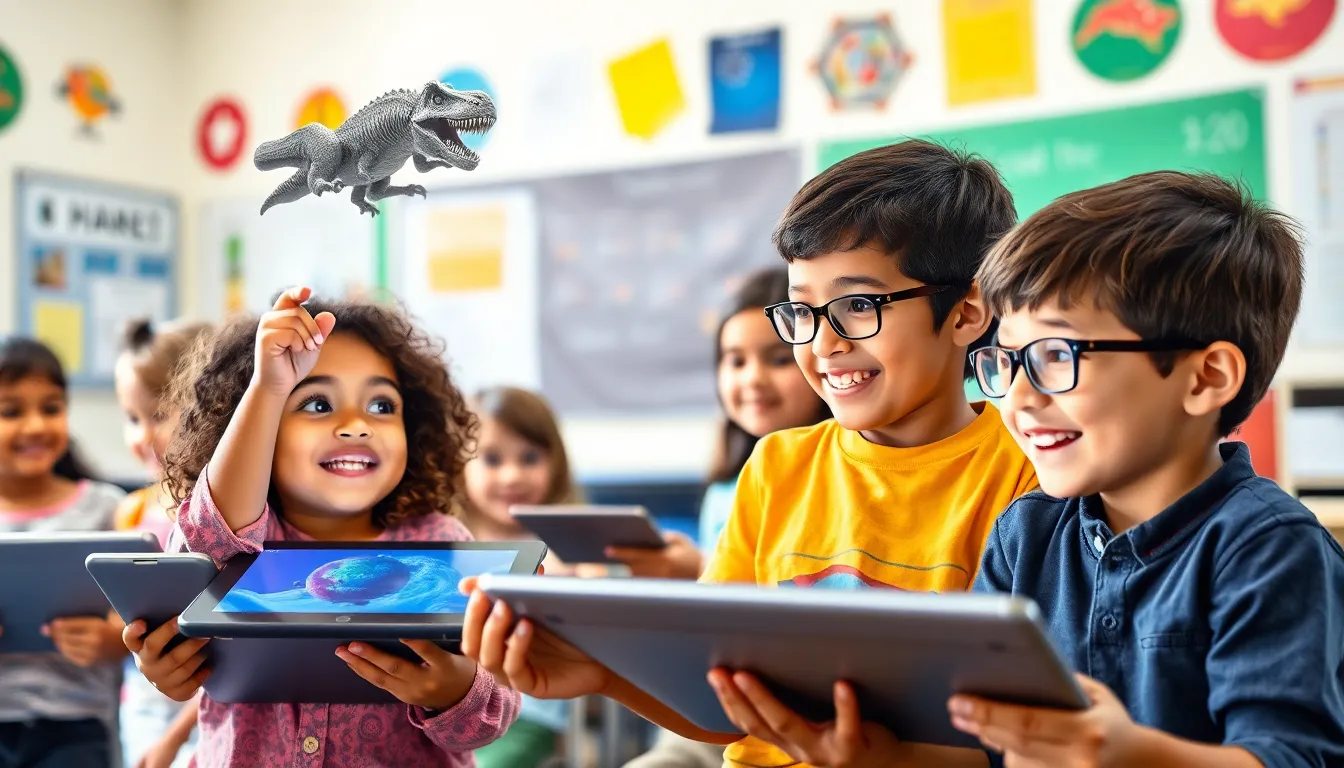Table of Contents
ToggleImagine a world where dinosaurs roam your backyard or outer space is just a step away in your living room. Welcome to the magical realm of augmented reality (AR) for kids! This innovative technology isn’t just for gamers and tech enthusiasts; it’s transforming the way children learn, play, and explore.
Overview of AR for Kids
Augmented reality (AR) offers engaging and interactive experiences tailored for children. This innovative technology transforms the way kids learn, play, and discover their environment.
Definition of Augmented Reality
Augmented reality enhances real-world environments with digital content. It overlays computer-generated images, sounds, and other sensory inputs onto the physical world. Users can view these elements through smartphones, tablets, or AR glasses. Applications often include educational tools, games, and interactive stories. Through AR, children’s imaginations come alive as they interact with digital objects in real time.
Importance of AR for Children’s Learning
AR significantly boosts children’s learning experiences. It encourages active participation and critical thinking. Engaging with 3D models of scientific concepts improves comprehension and retention. Studies show that kids exposed to AR tools tend to perform better in subjects like math and science. Visualizing complex subjects in an interactive format can also enhance creativity. By making learning enjoyable, AR fosters curiosity and promotes exploration.
Benefits of AR for Kids

Augmented reality (AR) brings numerous advantages for children, enhancing their experiences in learning and play. This technology fosters deeper engagement and has the potential to improve educational outcomes significantly.
Enhanced Engagement
Engagement levels soar when kids interact with AR. Children become active participants in their learning, captivated by vivid graphics and interactive content. Games designed with AR elements encourage exploration, as they challenge kids to solve problems and think critically. With the inclusion of digital characters and environments, children find motivation to delve deeper into their interests. They retain information more effectively when learning becomes a fun activity rather than a chore.
Improved Learning Outcomes
Learning outcomes benefit immensely from AR integration. Students grasp complex scientific concepts more easily when they visualize them in 3D. Engaging with content interactively leads to improved comprehension and retention rates, especially in subjects like math and science. Research indicates that students using AR technology perform better on assessments compared to traditional learning methods. Curiosity flourishes as children explore and discover new topics, solidifying their understanding. Ultimately, AR transforms educational experiences, making learning enjoyable and impactful for young minds.
Popular AR Apps for Kids
Augmented reality apps captivate children by merging learning with entertainment. Several standout applications allow kids to explore educational and recreational content.
Educational Apps
Educational AR apps enhance subjects like science and math through immersive experiences. Google Expeditions provides virtual field trips, enabling children to visit places like the Great Barrier Reef or the surface of Mars. Zooniverse allows young learners to contribute to real scientific research by observing wildlife or classifying galaxies. JigSpace teaches complex concepts using 3D models; kids manipulate and visualize structures such as the human skeleton or different types of machinery, making learning interactive and engaging.
Games and Entertainment Apps
Games also offer thrilling AR experiences that promote entertainment while fostering skills. Pokémon Go encourages physical activity as players catch Pokémon in their real-world surroundings. Minecraft Earth lets children build structures in AR, allowing creativity to flourish in their immediate environment. AR Dragon provides pet ownership experiences, with kids interacting, feeding, and taking care of their virtual dragon. These apps blend fun and learning, maintaining children’s interest in technology while developing essential skills.
Safety Considerations
Safety is crucial when introducing augmented reality (AR) experiences for kids. Parents and guardians should prioritize guidelines that ensure children’s well-being.
Screen Time Guidelines
Establishing screen time limits is essential for maintaining healthy viewing habits. Experts recommend that children aged 2 to 5 engage in no more than one hour of high-quality screen time each day. Balancing AR activities with physical play promotes overall development. Active monitoring of the content during AR sessions helps ensure that children interact with age-appropriate material. Encouraging breaks during prolonged use prevents eye strain and fatigue.
Content Appropriateness
Evaluating AR content for age appropriateness is necessary. Parents should opt for apps and experiences tailored to a child’s developmental stage. Review features like educational value, interactivity, and suitability before use. It’s important to verify that the augmented content does not include violence or inappropriate themes. Engaging with apps recommended by educators or authoritative sources enhances the experience while aligning with educational goals. Familiarity with the content allows parents to make informed decisions about what their children engage with while exploring AR.
Future of AR in Child Development
The future of augmented reality (AR) in child development holds immense promise. Innovations are set to enhance learning and engagement through immersive experiences.
Innovations on the Horizon
Emerging technologies will introduce even more exciting AR applications tailored for children. For instance, advancements in wearable devices could create seamless experiences, enabling kids to interact with educational content anywhere. Companies are developing AR glasses specifically designed for young users to engage with their surroundings dynamically. Enhanced machine learning algorithms will also personalize educational content, catering to individual learning paces. Interactive storytelling will likely evolve, allowing kids to influence narratives through AR, fostering creativity. Moreover, collaboration among children across various locations using AR environments promotes teamwork and social skills. These innovations will redefine how children learn, interact, and discover.
Potential Challenges
Implementing AR in child development does present challenges. Overexposure to screen time can lead to negative health effects, impacting vision and attention spans. Some children may struggle with content designed without considering developmental appropriateness. Ensuring safety in AR experiences is crucial, as not all applications follow strict regulations. Parents must also navigate the vast amount of available content, distinguishing between educational and purely entertaining programs. Balancing AR interaction with real-world activities remains essential for holistic development. Addressing these challenges requires collaboration between educators, developers, and parents to create safe and effective AR environments.
Augmented reality is reshaping the landscape of children’s learning and play. By merging digital content with the real world, it offers unique opportunities for exploration and engagement. Kids can dive into interactive experiences that spark their curiosity and enhance their understanding of complex concepts.
As AR technology continues to evolve, it promises even greater innovations that will further enrich educational experiences. Parents and educators must remain vigilant in selecting appropriate content while encouraging a balanced approach to screen time. Embracing AR can lead to a more dynamic and effective learning environment for children, fostering skills that will benefit them for years to come.







